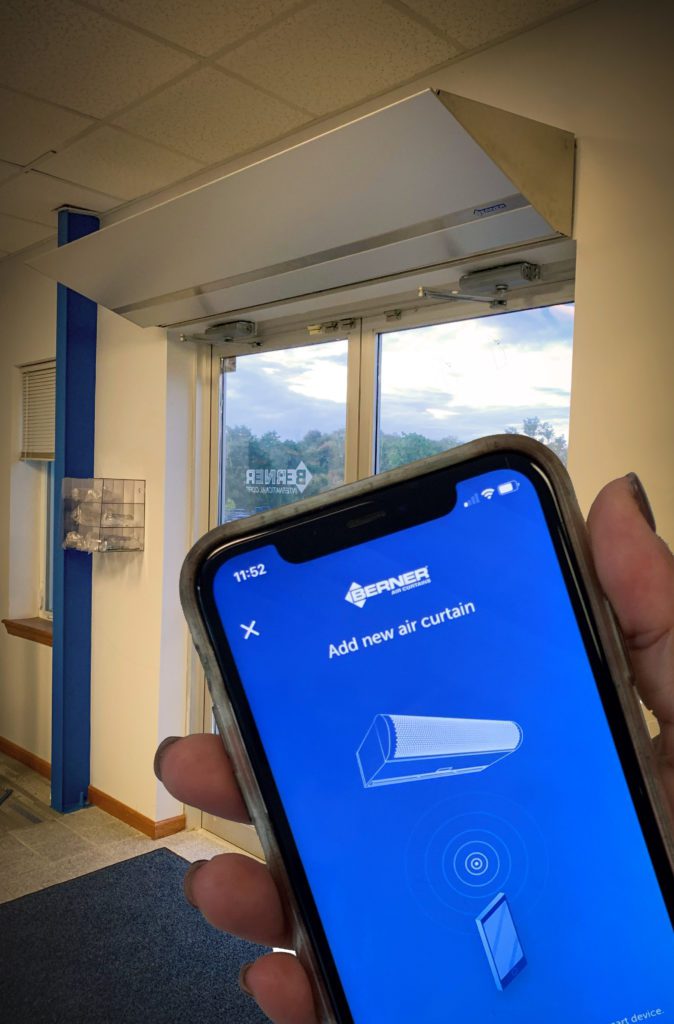
Adding an air curtain over a grocery store entrance is the equivalent to removing 14 cars from the road per year in greenhouse gas emissions. Market research consistently reports that both Millennials and Gen Z actively believe in reducing their carbon footprint, that they value experiences, and that they are willing to pay more for sustainability and environmentally-friendly alternatives.
For a long time, the conversation with owners has focused on energy conservation as it translates into dollars saved on the utility bill. Now, stakeholders are shifting the discussion to include not just the energy savings but the subsequent reduction in greenhouse gas (GHG) emissions from fossil-fired electricity generation and heating oil and natural gas transmission and use.

Along with that, the standards of what is acceptable to occupants of commercial and industrial buildings, whether they are customers, guests, patients, students, or employees have changed. Building occupants today expect comfort and good air quality, and assume that the building is operating in the best interest of their general health and well-being.
Reducing the carbon footprint of the built environment while maintaining the health and well-being of building occupants is a balancing act of sustainability goals that specifiers know well. The benefits of sustainable buildings are well documented, and the specifier community has played (and continues to play) a huge part in the creation, adoption, and promotion of green building standards (LEED, BREEAM, LBC, Green Globes, WELL, etc.) and commercial energy building codes (ASHRAE 90.1, ASHRAE 189.1, IECC, IgCC, ENERGY STAR).
Berner air curtains save energy / reduce carbon footprint
Running a sample calculation for a 1829 mm wide, 2134 mm high (72 in. wide, 84 in. high) entrance into a grocery store in Pittsburgh, Pennsylvania, whose hours are 8am–8pm, whose doors are physically open seven days a week for an average of five hours a day, tells us that the store will save 314.3 MMBtu per year or about $2228 in energy costs.
If we take the “Total MMBtu Saved” output of the Berner Energy Savings Calculator (in this case, 314.3 MMBtu) and convert it to kWh, we can then input this number into several GHG emission reduction calculators, including the U.S. EPA Greenhouse Gas Equivalencies Calculator. Using the above example, the EPA’s GHG Equivalencies Calculator tells us that the 314.3 MMBtu saved by the air curtain is the equivalent of 65.3 metric tons of carbon dioxide or greenhouse gas emissions from 264,024 km (164,057 miles) driven in a year by an average passenger vehicle. Said differently, adding the air curtain equates to removing 14.2 cars from the road or saving 32 ha (80 acres) of U.S. forest a year.
Major energy codes allow air curtains as substitutes for vestibules

ASHRAE 90.1-2019, Energy Standard for Buildings Except Low Rise Residential Buildings, the International Energy Conservation Code (IECC) and the International Green Construction Code (IgCC) building codes all include AMCA-certified air curtains as an exception to vestibules. Working with the Air Movement and Control Association International (AMCA), Berner International, the leading manufacturer of air curtains, led an industry-wide push for third party research regarding the efficacy, performance, and benefits of air curtains. The outcome of these efforts was official recognition by several code bodies that air curtains combined with vestibules work as well, or better than, vestibules at saving energy. It’s worth mentioning that the research showed that while air curtains work better than a vestibule, air curtains combined with a vestibule work the best at protecting against energy loss through the entrance as people come and go. The codes require an air curtain to have been tested in accordance with ANSI/AMCA 220, and after installation to have a minimum velocity of 400 feet/minute (2.0 m/s) at 6.0 inches (15 cm) above the threshold. One can verify that an air curtain has been AMCA tested and certified using AMCA’s Certified Product Search.
Berner air curtains support the experience
Have you ever shivered along with a bundled-up grandparent or parent inside a hospital entrance, waiting for the car to arrive? Have you ever met a friend at a bar or restaurant, but found that your seat near the door was too cold to enjoy being there? How about trying to hang out with friends or associates in a hotel lobby? Have you ever been so cold due to the door opening and closing that while stylish, and filled with comfortable couches and seats, you couldn’t wait to get out of there? Conversely, it’s summer, and the AC is on. Everyone is still freezing, because the constant opening and closing of the door is causing the air conditioning to run non-stop.
This is where the air curtain comes in. Air curtains create a barrier out of air that allows people to pass in and out of a building, while keeping the conditioned air in and the unconditioned air out. This air stream barrier helps to stop uncomfortable drafts from ruining the in-space experience. In addition to providing a barrier, the air curtain unit helps to de-stratify room air by reducing built-up thermal layers and airflow dead zones, reducing the space’s hot and cold spots. The action of drawing air from across the ceiling into the air curtain’s intake also assists in the distribution of the supply air from the air handling unit. This is an increasingly appreciated benefit when additional filtration has been added, as part of a building’s COVID response, reducing the throw of supply air from the registers. This additional aid in the distribution and dilution of room air further supports the thermal comfort and well-being of those inside the door.
Building occupants want to feel good about the spaces they occupy when they shop, when they eat, when they hang out, when they are taking care of themselves or others, and when they work. By protecting the interior temperature (and thus the comfort) of the space inside the entrance when the door is open, air curtains help to protect the ambiance. This protection of the interior temperature also protects against the loss of conditioned air (air conditioned or heated) through the opening. This translates into reduced load and cycling of air conditioning and heating systems. Which means less energy required, which in turn means less GHG emissions.
In addition to thermal comfort, air curtains are well recognized by health departments, the FDA, the USDA and other entities for their ability to prevent flying insects from entering a space without the use of chemicals. They are also used by Emergency Rooms, Drive-thrus, and Shipping/Receiving to keep vehicle exhaust (carbon monoxide) and cigarette smoke out.
Berner air curtains support people, planet, and profit

Properly sized, installed and operated, air curtains save energy and protect the thermal comfort of the area interior to the door. When the door is open, Berner air curtains support the Triple Bottom Line:
People: thermal comfort, IAQ, well-being
Planet: energy conservation & GHG emission reduction, chemical-free insect control
Profit: energy savings, increased customer/patient/occupant satisfaction & employee productivity
According to the The Global Sustainability Study 2021*, conducted by global strategy and pricing consultancy Simon-Kucher & Partners, more than one third of global consumers are willing to pay more for sustainable products and services. As our population becomes more eco-conscious in their choices, meeting sustainability goals becomes more important in our building products, designs, construction, and operations.
Berner.com has CSI specifications, performance data, CAD & revit files
So much effort goes into making our indoor spaces a positive and welcoming experience, into making a good impression through design, and into reducing our carbon footprint without reducing indoor air quality. To make it simpler for specifiers to use air curtains on their projects, Berner not only has good looking, quiet, high performing air curtains to choose from, but has put supporting documentation and information online so that it can be easily and quickly found. Go to Berner.com to find photos and images, product information including CSI specifications, and technical support. The site includes information regarding certifications, building codes and air curtains, an air curtain selection tool, and the simple-to-use energy savings calculator.
In addition to the Berner website, our experienced, factory-trained representatives have the expertise to guide you through air curtain selection, voltages, accessories, control panels (for Industrial air curtains), mounting options, custom finishes, etc., as well as prepare submittals and other documentation needed.
Research
Air Curtains as an Alternative to Vestibules.
Gen Z, Millennials Stand Out for Climate Change Activism, Social Media Engagement With Issue
8 Characteristics Of Millennials That Support Sustainable Development Goals (SDGs)
FMI: Corporate Social Responsibility
NielsonIQ: The 2022 state of consumers
Not your average calculator – Greenhouse Gas Equivalencies Calculator
Greenhouse Gases Equivalencies Calculator – Calculations and References
Discover the path to energy efficiency
Originally published on The Construction Specifier on March 21, 2022